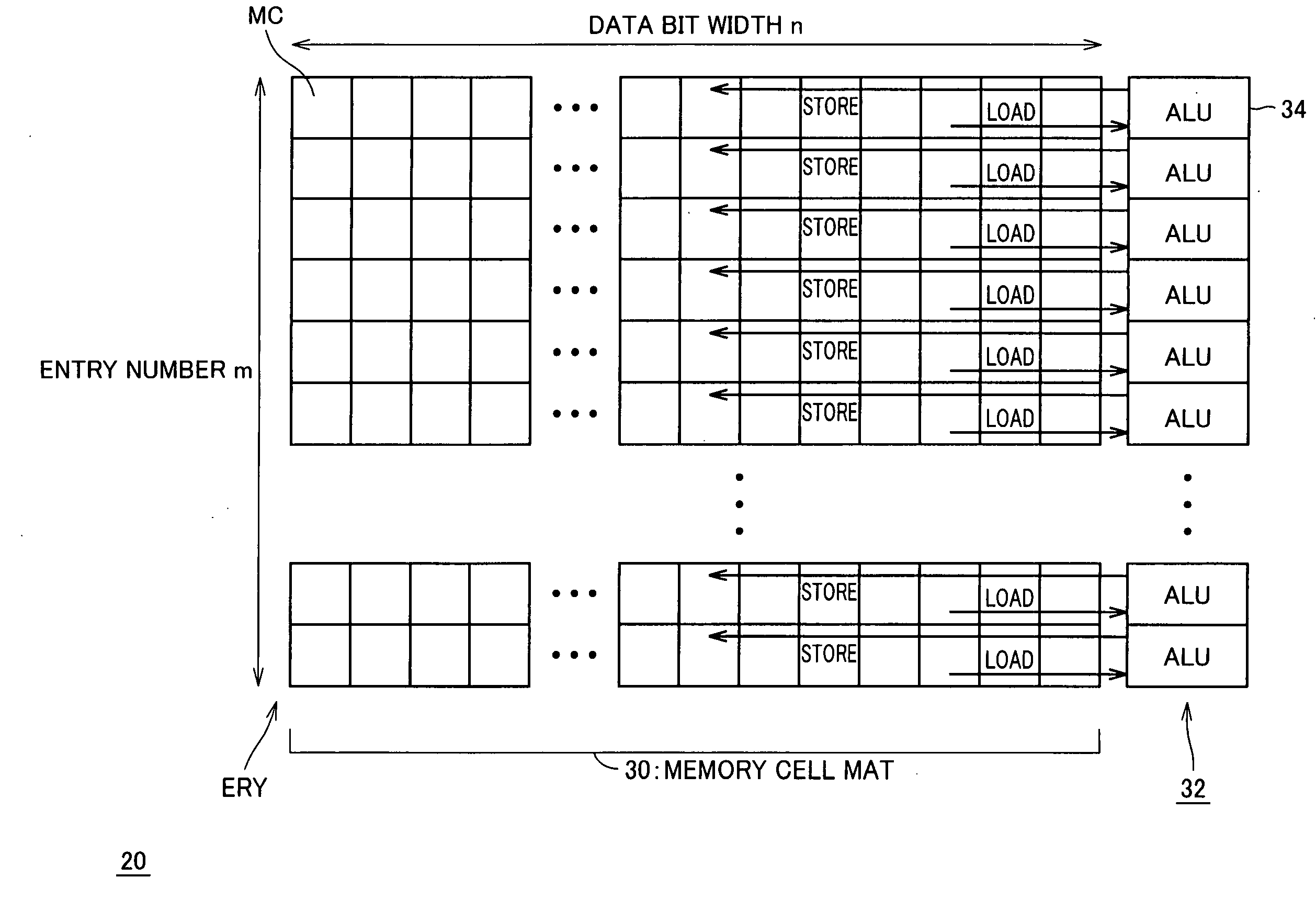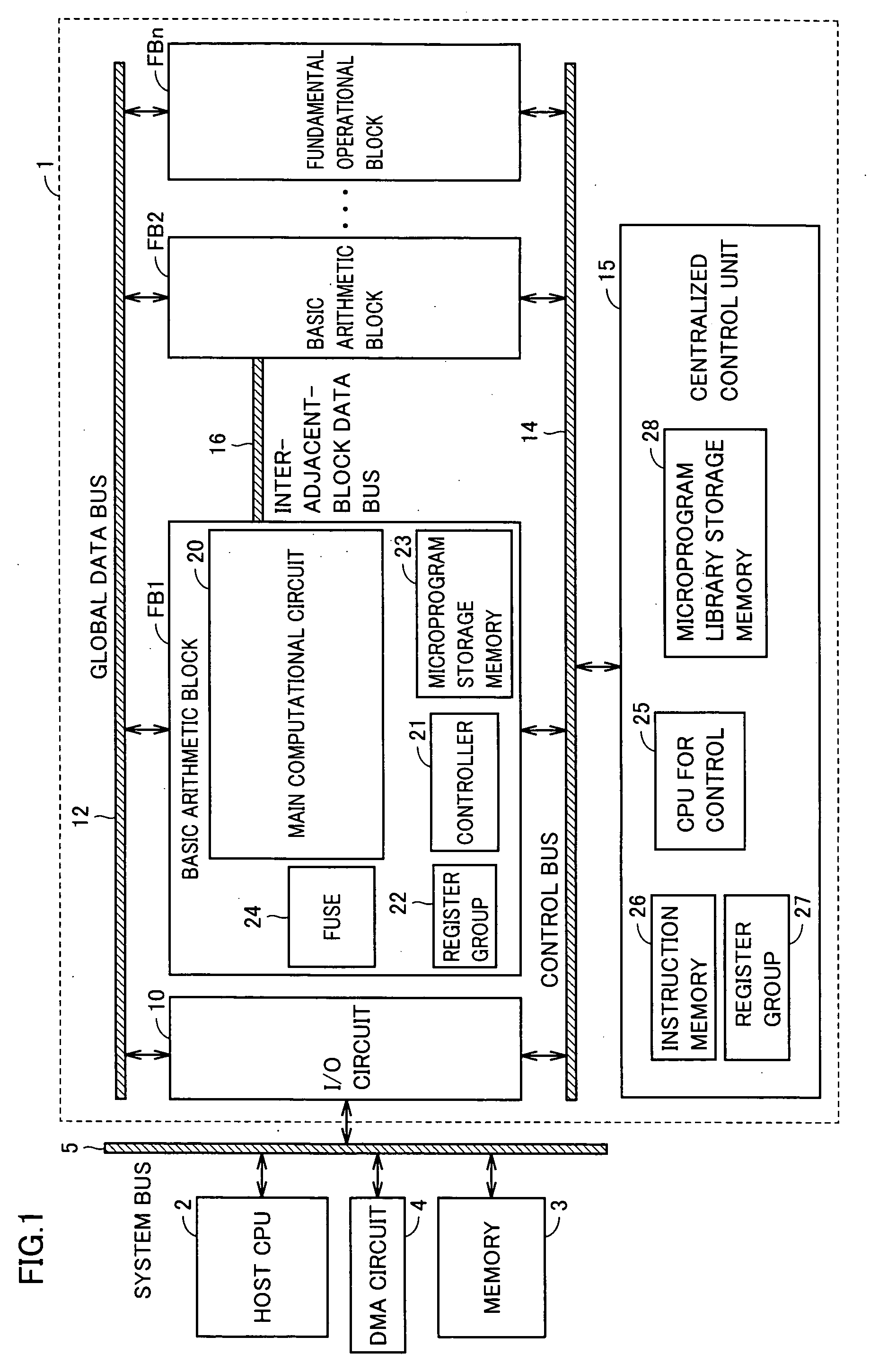Semiconductor signal processing device
a signal processing and semiconductor technology, applied in the field of semiconductor signal processing devices, can solve the problems of difficult to dramatically improve performance, inability to fast processing, and long time in proportion to the quantity of data, so as to achieve efficient operation. the effect of processing
- Summary
- Abstract
- Description
- Claims
- Application Information
AI Technical Summary
Benefits of technology
Problems solved by technology
Method used
Image
Examples
first embodiment
[0123]FIG. 7 schematically shows a whole construction of a signal processing system which uses a semiconductor signal processing device according to a first embodiment of the invention. In FIG. 7, signal processing system 50 includes a system LSI 52, which implements an operational processing function of executing various kinds of processing, and external memories connected to system LSI 52 via an external system bus 56.
[0124] The external memory includes a large capacity memory 66, a fast memory 67 and a Read Only Memory (RAM) 68 storing fixed information such as instructions used in system startup. Large capacity memory 66 is formed of, e.g., a clock Synchronous Dynamic Random Access Memory (SDRAM), and fast memory 67 is formed of, e.g., a Static Random Access Memory (SRAM).
[0125] System LSI 52 has, e.g., a SOC (System On Chip) structure, and includes fundamental operational blocks FB1-FBn coupled in parallel to an internal system bus 54, host CPU 2 controlling processing operat...
second embodiment
[0193]FIG. 18 schematically shows a construction of main computational circuit 20 according to a second embodiment of the invention. Main computational circuit 20 has a memory cell mat 95 in which two-port SRAM cells MCS are arranged in rows and columns. Two-port SRAM cell MCS has substantially the same structure as that shown in FIG. 11.
[0194] In memory cell mat 95, word lines WLV are arranged perpendicular to word lines WLH. Bit line pairs BLHP are arranged parallel and corresponding to word lines WLV, and bit line pairs BLVP are arranged parallel and corresponding to word lines WLH.
[0195] A row decoder 100 selects word line WLH, and a row decoder 102 selects word line WLV. Word line WLV and bit line pair BLHP are connected to SRAM cells MCS included in a common entry ERY.
[0196] The sense amplifier in sense amplifier group 40 and the write driver in write driver group 42 are arranged corresponding to entry ERY, and the arithmetic and logic unit (ALU) in operational processing u...
third embodiment
[0215]FIG. 25 schematically shows a construction of main computational circuit 20 according to a third embodiment of the invention. In main computational circuit 20 shown in FIG. 25, an orthogonal two-port memory cell mat 130 is arranged adjacent to memory cell mat 30. Memory cell mat 30 includes memory cells of a single port construction in rows and columns. Word lines WL are arranged corresponding to memory cell rows, respectively, and shared bit line pairs CBLP0-CBLP(m-1) each shared by memory cell mats 30 and 130 are arranged corresponding to the memory cell columns, respectively.
[0216] In orthogonal two-port memory cell mat 130, bit lines BLVP are arranged perpendicularly to shared bit line pairs CBLP0-CBLP(m-1). Word lines WLV are arranged parallel and corresponding to shared bit line pairs CBLP0-CBLP(m-1), respectively, and word lines WLH are arranged parallel and corresponding to bit line pairs BLVP, respectively. Orthogonal two-port memory cell mat 130 includes two-port me...
PUM
 Login to View More
Login to View More Abstract
Description
Claims
Application Information
 Login to View More
Login to View More - R&D
- Intellectual Property
- Life Sciences
- Materials
- Tech Scout
- Unparalleled Data Quality
- Higher Quality Content
- 60% Fewer Hallucinations
Browse by: Latest US Patents, China's latest patents, Technical Efficacy Thesaurus, Application Domain, Technology Topic, Popular Technical Reports.
© 2025 PatSnap. All rights reserved.Legal|Privacy policy|Modern Slavery Act Transparency Statement|Sitemap|About US| Contact US: help@patsnap.com



